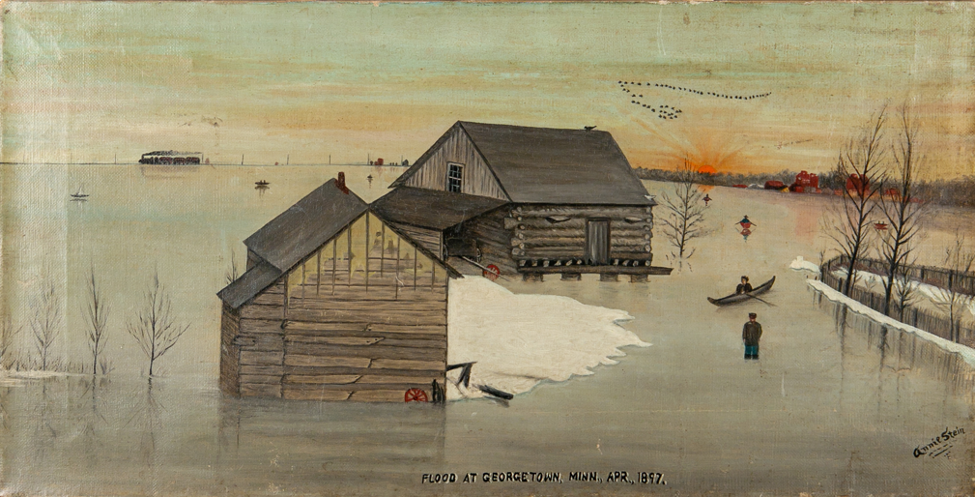
Adam Stein later settled in Georgetown. His daughter Annie Stein painted this depiction of their family home in the Flood of 1897.
Clay County Histories
Markus Krueger | Program Director HCSCC
I don’t want to jynx it, but I don’t think we are going to get one of those “Hundred Year Floods” that we get every ten years or so. Many of us remember the big ones in 2009 and 1997, and local history fans know that 1897 was a doozy. The first US settlers came to this section of the Red River Valley in 1859. Two years later, they found out that it floods around here. Adam Stein, one of Clay County’s earliest pioneer settlers, was there and left this account.
“1861 was the spring of the very high water. Water covered the floor of the shanty, on my claim, now the property of the Lamb Bros., Moorhead. I hitched up my oxen and Dan Miller and I drove to Banning’s point, a place about nine miles north of Lewiston station, to look after some potatoes which I had stored in Mr. Banning’s shed. We picked up Mrs. Will Roundsville and two children on our way back who were living near the ravine, a few miles north of the station, and left them at Lewiston station, then returned to the point before the water got too high.”
Stein’s story happened around Moorhead ten years before the Northern Pacific Railway founded the city. The “Lewiston Station” he talks about was a log stagecoach station where the Wild Rice River flows into the Red about 4 miles south of Bluestem Amphitheater. Our county’s original 1859 surveyor’s maps show a ravine a couple miles north of that, so the Roundsvilles must have lived behind Moorhead Memorial Gardens Cemetery. “Banning’s Point” would be a bend in the river nine miles north of Lewiston Station – that matches the description of Viking Ship Park behind the Hjemkomst Center. Stein continues:
“The country was covered with about four feet of water. Richard Banning, Daniel Miller, John Anderson, whom we called ‘Robinson Crusoe,’ and myself were obliged to live in a wagon box for four days, while the water was at its highest point. The box was set on the joists of Mr. Banning’s building. We had a table standing at one side of the box, and up on this was our cook stove, which just reached to the top of the box. For wood, ‘Robinson Crusoe’ would strip off his trousers and wade out to where the ends of fence rails stuck up above the water and would saw them off. For water we just reached over the box.
“We had, in our box, besides us four fellows, seven bushels of potatoes, bedding, etc.. Before the water went entirely down, I hitched up my team of oxen again and took my potatoes and drove back to Lewiston station. Dan Miller went with me. We drove through water all the way.”
The guys working at the Hudson’s Bay Company warehouse in Georgetown, Stein said, weathered the flood on the second floor of a log house. A boat tied to the stairs gave them transportation.

